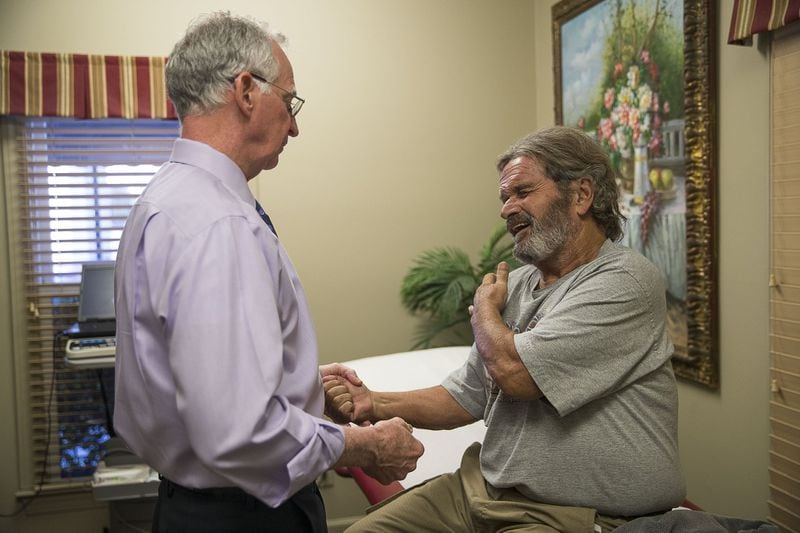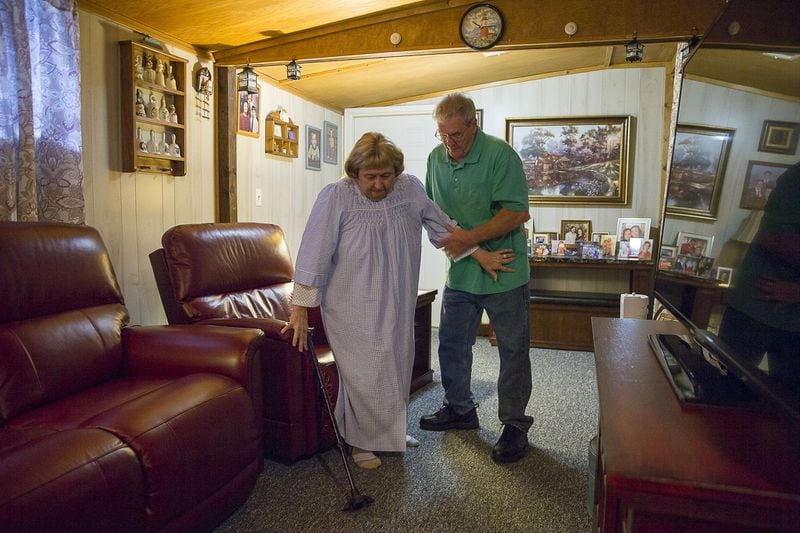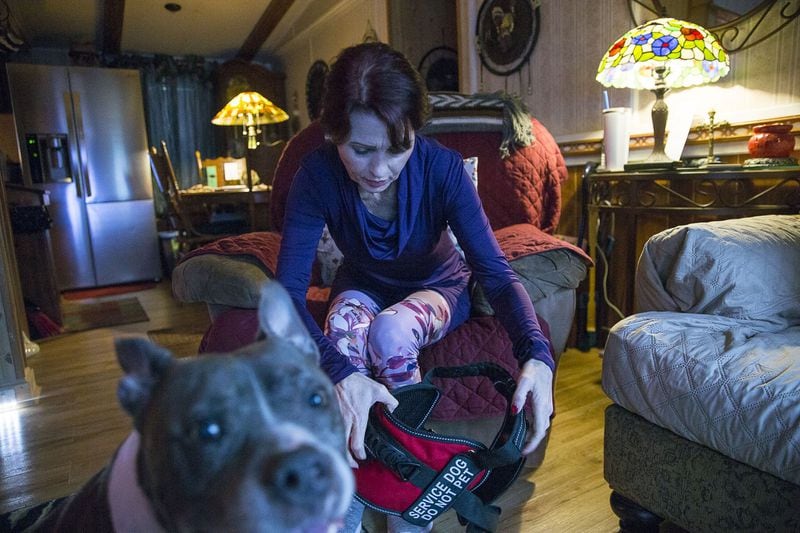Veterans shattered by roadside bombs. Amputees. Motorists crushed in car crashes. People wracked by cancer. These are some of the pain patients flocking to Dr. John Downey’s medical office here.
Downey watches them wince. He hears them moan. He sees them crying in his exam rooms as their nerves fire off dagger-like messages to their brains.
The doctor faces a dilemma: He knows painkillers like oxycodone and hydrocodone will help. But he is concerned about the deadly risks amid the opioid abuse epidemic, a crisis that has killed hundreds of thousands of people and triggered lawsuits against drug manufacturers, distributors and physicians like him.
There is a lot of stake for Downey — his reputation, his state medical license, his livelihood — amid a government clampdown on opioids that he and many other doctors across the country say is well-intentioned but has possibly gone too far.
Compounding his quandary, Downey keeps attracting hundreds of new patients, many of them turned away by other physicians spooked by the epidemic. His annual medical malpractice insurance premium, meanwhile, has more than doubled to about $18,000 because of the risks.
All of it leaves him wondering if now is the time to retire.
“You kind of realize you are putting yourself out on a limb for these patients,” Downey said, “and some of those limbs are tiny little branches — twigs.”
Pull-ups and puns
A Pennsylvania native and Army veteran, Downey, 66, runs his Royal Pain Center in an unglamorous setting — a suburban office park that features a hospice and sits across from a Waffle House. His office routinely sees more than 2,000 patients within a three-month span.
Downey founded his practice more than two decades ago after studying osteopathic medicine — a holistic approach that involves manipulating muscles and bones in diagnosis and treatment — and after caring for troops at several military hospitals, including the Eisenhower Army Medical Center at Fort Gordon. He specializes in physical medicine and rehabilitation, a medical branch that focuses on a variety of conditions affecting the brain, spinal cord, nerves, bones, joints, ligaments, muscles and tendons.
In 2015, then-Gov. Nathan Deal appointed him to the Georgia Composite Medical Board, which licenses, investigates and disciplines doctors. He got so busy taking in new pain patients that he did not seek reappointment. But he still serves as the board’s appointee to a committee that oversees Georgia’s Prescription Drug Monitoring Program, a database that helps doctors identify patients who already have been prescribed dangerous amounts or combinations of drugs.
Lean and wiry, Downey copes with the stress of seeing so many traumatized patients by regularly doing pull-ups on a shiny metal bar suspended in his office doorway. He finds peace teaching himself to play the piano on a keyboard set up over his desk.
Downey recently stepped inside one of his exam rooms to see a longtime patient, Tyrus “Larry” Johnson Jr., 78, a retired utility systems operator. Johnson sustained a back injury in the U.S. Army while unloading ammunition containers. Afflicted by stenosis, neuropathy and gout, he had a cancerous kidney removed along with his spleen and gallbladder and has undergone surgery on both knees and elbows.
Johnson relishes recalling his glory days playing football, baseball and softball — he is named after National Baseball Hall of Famer Ty Cobb — and restoring Pontiac Firebirds and Chevrolet Camaros. Many of his athletic trophies are on display in his modest home in North Augusta, S.C. A bright red “State Champ” softball team jacket still hangs in his closet.
These days, Johnson mostly sits in his recliner, watching television, feeding Milk Duds to his Shih Tzu, Diego, and fighting off the pain. The garages across from his home, where he used to restore cars, are empty and laced with cobwebs. When people ask him how he’s doing, he replies: “I’m falling apart.”
Johnson brightened when Downey walked through the exam room door.
“My buddy,” Johnson said.
Downey: “How are you doing pain-wise?”
Johnson: “My medication is fine.”
They chitchatted about the weather. Then Downey asked Johnson to climb atop the exam table.
Downey: “Any side effects from the medicine we need to worry about: constipation, nausea, drowsiness, dizziness, teeth falling out?”
Johnson told him he had suffered from dizziness over the last few months and that his heart doctor told him he may need a pacemaker. Downey tapped Johnson’s knees with a rubber instrument, testing his reflexes and deadpanning: “I do it for kicks.” To Downey, puns are medicinal because they elicit smiles from his patients. He joked that Johnson could get a special meal at the Waffle House across the street, saying they serve “Scrambled Aches” and “Pain Cakes” there.
Johnson said he wouldn’t be able to raise his arms, walk, cut his grass or go to the gym without the oxycodone Downey prescribes.
Pain is subjective, so Downey must rely largely on what Johnson and his other patients tell him. To determine the right dosages, Downey uses a point system. Points are granted for surgeries, family support, employment, attempts at nonopioid treatment and complaints of chronic pain. Points are deducted for smoking, depression, anxiety, substance use disorders and taking benzodiazepine, an anti-anxiety drug and that can increase the risk of a fatal overdose when combined with opioids.
Like Downey’s other patients, Johnson must abide by a written contract that says he will show up for his appointments, get his painkiller prescriptions only from Downey and take them as instructed. The contract requires random drug screens and allows family members to attend appointments and weigh in on treatment. As many as three patients are discharged each day for breaking the rules, said Downey’s wife, Cindy, the medical practice’s vice president.
“If you go by our rules, you are welcome to stay,” she said. “If you don’t, we don’t hesitate to get rid of you. We are both like that. If you have any cross words with our staff, you are out of here immediately. No more visits. We don’t put up with that.”
The fifth vital sign
Downey remembers when influential physicians — backed by the American Pain Society and the Veterans Health Administration — began promoting the idea in the 1990s that pain should be treated as a fifth vital sign, a health indicator just as important as blood pressure, pulse, respiration and temperature. Around that time, Purdue Pharma introduced OxyContin, a powerful opioid painkiller that would figure in the nation’s overdose epidemic.
Following heavy promotion by drug manufacturers, opioid prescriptions rose nationwide for years before peaking at 255 million in 2012. From 1999 to 2017, according to the Centers for Disease Control and Prevention, nearly 218,000 people in the United States died from overdoses related to prescription opioids.
Families of overdose victims are suing the doctors who issued their prescriptions. Municipalities and states are pursuing their own lawsuits, citing massive health care and public safety costs. The Drug Enforcement Administration has boosted its scrutiny of pain doctors like Downey, carrying out announced inspections of their offices.
No violations were found during a routine inspection of Downey’s office, said Mike Hargroder, the diversion program manager for the DEA’s Atlanta field division. Hargroder, who wasn’t sure of an exact date of the inspection but said it occurred within the last four years, added about Downey: “He does a lot of due diligence with his clientele.”
The increased scrutiny has prompted more caution among doctors — Opioid prescriptions fell by 13% between 2016 and 2018 in Georgia.
Downey is not a fan of much medication — he takes only Vitamin C — and he encourages alternatives, such as dieting, physical therapy and exercise. But those methods, he said, aren’t sufficient for everyone, especially people he calls “legacy pain patients,” or people with chronic pain who have relied on opioids for years.
In 2017, Downey had 10,822 Medicare claims for opioids, including refills, while prescribing the sixth highest total, as measured by the government, among Georgia doctors, according to the federal Centers for Medicare and Medicaid Services.
“I just know that some people are suffering and need some relief,” Downey said. “And not all of them can go to the gym. And some of them already have had several surgeries and injections.”
Sheryl Durden falls into this category, according to Downey. A retired high school teacher, Durden, 68, suffers from stenosis, arthritis and neuropathy. She had both knees replaced. Just standing hurts, so she spends most of her days lying in bed or sitting in her La-Z-Boy recliner.
Durden has tried numerous alternatives to opioids: Extra Strength Tylenol, water aerobics, physical therapy and chiropractic care. The methadone and oxycodone Downey prescribes her do the most to help her cope, though she is still in pain, she said.
“I can take a lot stronger medication than what he is giving me, but I hold back,” she said. “I keep mine down as much as I can because I don’t want to be a zombie and just lay around all the time.”
Much of what she needs is in reach of her La-Z-Boy at her tidy home in Warrenville, S.C.: her sweet dachshund, Maddie. The iPad she uses to draw, play Scrabble and watch YouTube videos. Her stationery and pens. Her protection, a blue-handled .38-caliber pistol. From her recliner, she can see her framed family photos and her grown son’s many boxing trophies.
Durden’s doting husband of 45 years, Carl, pushes her in a wheelchair and does their cooking, housecleaning and laundry. He helps her bathe, get dressed and take her medicine on time. Sheryl has told him that if she were to stop breathing for any reason, she does not want to be resuscitated. Carl won’t agree to that.
Still, he said, "I want to outlive her, because I don't know what would happen to her if something were to happen to me."
‘On vacation every day’
Many experts are wary of opioids. Dr. Erin Krebs, who teaches at the University of Minnesota Medical School, was part of a team of researchers that spent a year observing the treatment of 240 Veterans Affairs Department patients with back, hip or knee pain. Published in 2018, the team's results showed opioids did not work significantly better than nonopioid medications in treating their pain. Patients, Krebs added, can build up a tolerance to opioids, causing escalating pain and requiring them to take higher dosages to maintain the same levels of relief.
“Often, I think people get started on opioids and they just keep going on them, and there isn’t that all important reassessment,” she said. “How do we know that the opioids are really helping you anymore? For many people, I think it turns out they aren’t. But, because we haven’t been careful about reassessing and following up, it can be hard to say.”
Dr. Tom Frieden, the former director of the CDC, is blunt about the risks, saying doctors, should think twice before prescribing opioids in the first place. Physical therapy with strengthening exercises, cognitive behavioral therapy and Motrin and Tylenol, he added, are “markedly safer and at least as effective — and likely more effective.”
“Every new opiate prescription is a momentous decision. There isn’t any class of medications that kills as many Americans,” said Frieden, now the CEO of Resolve to Save Lives, a global health initiative based in New York.
Under Frieden’s watch, the CDC issued guidelines in 2016, advising doctors against increasing opioid doses to more than 90 MME, or morphine milligram equivalents. A backlash from doctors and chronic pain patients in Georgia and across the nation quickly followed, prompting the CDC to issue a new statement this year advising against misapplying the guidelines. In October, the government issued yet another new set of guidelines warning about the dangers of rapidly reducing painkillers for patients who have become physically dependent on them. Anxiety, depression and suicidal thoughts are among the dangers.
Downey announced to his patients last year that he would begin gradually tapering their pain medication. Angered and confused by the CDC’s 2016 guidelines and feeling unfairly stigmatized, many of his patients wrote Downey letters saying the government should back off. Downey forwarded their complaints to federal health officials.
Among his patients who sounded off was Darlene Wright of Augusta. She said she had an out-of-body experience after narrowly surviving a car crash three years ago. The collision damaged her brain stem and spine. Wright, 57, went into a coma and contracted an infection in the hospital. She remembers floating out of her body and seeing herself on the operating room table. Then she remembers the excruciating pain — and sadness — she felt when she regained consciousness.
Compounding her troubles, Wright suffers from rheumatoid arthritis, osteoporosis and fibromyalgia. She has undergone three back surgeries and has suffered a heart attack. Last year, she fell and broke a hip. Under Downey’s supervision, she takes oxycodone for her pain. She said she wouldn’t be able to get out of bed without those pills.
“It feels like my bones are breaking inside my body,” said Wright, who speaks softly and walks gingerly.
Wright recently showed up for a routine appointment at Downey’s office, complaining to nurse practitioner Jenni McCarthy that she had experienced chest pains and could not feel her feet. McCarthy reached down and held her legs.
McCarthy: “Are you feeling me touch you?”
Wright: “No. I don’t have any feeling from my knees down to the bottom of my legs.”
McCarthy tested her for weakness, attempting to pull her arms apart and then push them back together.
“Fight me. Fight me. Fight me,” she told Wright, who strained to resist.
McCarthy then injected Wright’s neck with a pain reliever.
Wright worries the CDC’s 2016 guidelines are a step toward blocking her pain medication.
“I understand there are people out there who abuse the medication,” she said. “I totally get that. But it hurts the ones of us who are really disabled and makes it very hard for us to go to the doctor and get treated and get the medication we need.”
Though Downey has considered quitting amid all the risks and scrutiny surrounding opioids, he loves his job. He loves the detective-like work in discovering the sources of pain. He loves seeing his patients’ eyes light up when he helps them recognize what is causing their suffering and what can be done to keep it at bay.
He worries what would happen to them if he were to shut his doors.
“I tell my patients I am on vacation every day. Then I tell them I lose sleep over them,” he said. “I do enjoy taking care of these people, and if I didn’t have something like this to do, I don’t know what I would do.”
Top 10 opioids, by number of prescriptions written, in Georgia*
1. Hydrocodone SA, 2,633,956
2. Oxycodone SA, 1,748,749
3. Tramadol SA, 1,597,438
4. Codeine, 430,621
5. Buprenorphine, 371,036
6. Morphine LA, 195,548
7. Fentanyl LA, 127,338
8. Morphine SA, 89,208
9. Methadone, 88,995
10. Oxycodone LA, 83,633
*Statistics from 2018
SA: Short Acting
LA: Long Acting
Opioid prescriptions in Georgia
2016: 8,589,707
2017: 8,001,050
2018: 7,487,527
% Change 2016-2018: 13
Opioid patients in Georgia
2016: 2,331,269
2017: 2,177,640
2018: 2,018,390
% Change 2016-2018: 13
Opioid-related Overdose Deaths of Georgia Residents
2016: 904
2017: 996
2018: 873
Source: Georgia Public Health Department











